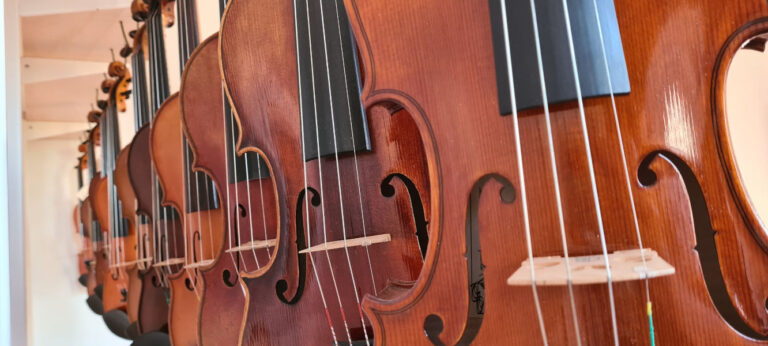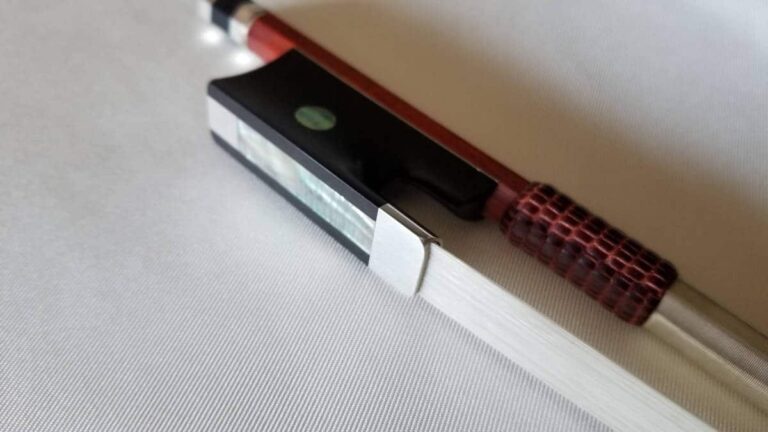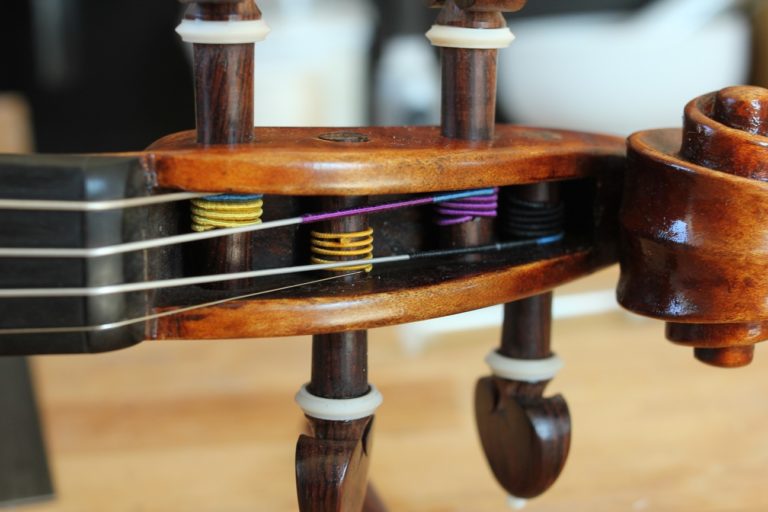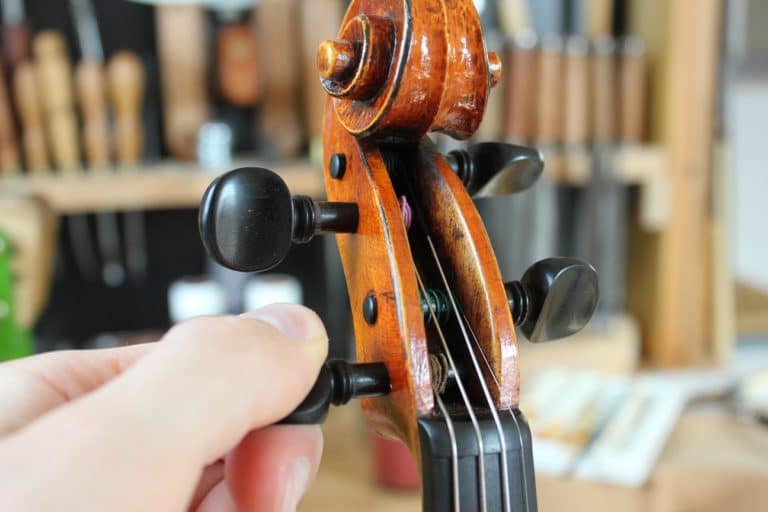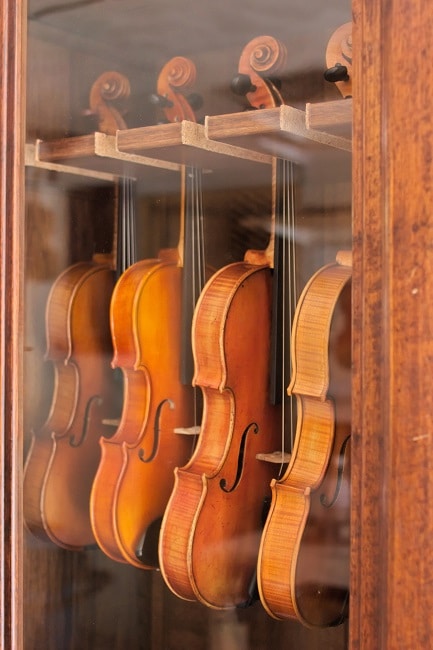Members of the violin family come in many sizes to fit growing players. This guide is intended to help you find the ideal instrument size for you or your child’s violin, viola, cello or double bass studies. A final decision about sizing should be made with the help of a professional music teacher, who will be able to determine what is best for the student in terms of their individual needs, musical capacities and morphology.
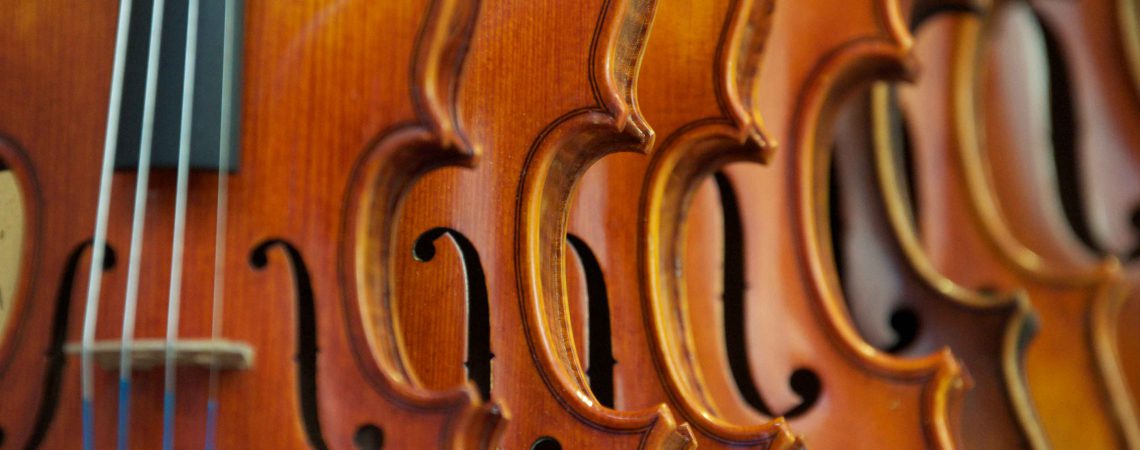
Measuring instruments
To begin, it is helpful to know that instruments are not measured by their total length. In most cases, violins, violas, cellos and double basses are measured by the length of their sound board. This measurement is most often reflected in centimeters or in millimeters.
Because of the inconsistency of viola sizing, sometimes the sizing is given in inches or in centimeters, and the full length of the instrument body is measured. We might also see the viola’s measurements based on vibrating string length (VSL).
Violin size guide
How to measure instrument size
How to get the musician’s arm length: fully extended the arm so it is parallel with the floor. Measure the length (in centimeters) from the neck to the middle of the palm.
| Reference size | Soundboard size | Musician arm length | Musician’s age (approximate) |
|---|---|---|---|
| 1/16 | 22.5 cm | 35-38 cm | 3-4 years |
| 1/10 | 24 cm | 39-42 cm | 4-5 years |
| 1/8 | 25.5 cm | 43-46 cm | 5-6 years |
| 1/4 | 27.5 cm | 47-51 cm | 6-7 years |
| 1/2 | 30.5 cm | 52-56 cm | 7-8 years |
| 3/4 | 33.5 cm | 57-60 cm | 9-11 years |
| 4/4 | 35.5 cm | 60 cm + | over 11-13 years |
We could also add 7/8 sized instruments to this chart, although it is less common. Often referred to as “ladies’ violins,” they would have been designed for more petite adults and are simply more comfortable for some musicians. This size can also be used by youth musicians who fall between the 3/4 and 4/4 sizes.
No-measure methods
As no two musicians are alike, these numbers and charts are not necessarily adapted to everyone. We cannot necessarily match size and age with a specific measurement. The following methods can be used to at least get an estimate, but it will ultimately be up to the musician to find an instrument that fits like a glove.
- Put your violin in playing position, with the first knuckle of your left index finger placed near the top nut (aka first position). Your left arm should form a 90° angle. If your arm is at an acute angle, the instrument is too small. If it is at an obtuse angle, the instrument is too large.
- Still in position, rest your chin on the chin rest and wrap your hand around the volute with your arm extended. If the volute is well placed in the palm when your arm is extended, then the instrument is the correct size. If your arm isn’t able to fully extend, then the instrument is too small. If the palm of your hand cannot reach the volute, the instrument is too large.
Viola size
How to measure instrument size
Just like with violins, fully extend your arm so it is parallel with the floor. Measure the length (in centimeters) from the neck to the middle of the palm of the hand. Note that viola sizes may be expressed in inches.
| Reference size | Viola size (in centimeters and inches) | Musician arm length |
|---|---|---|
| 1/8 | 28 cm (11 in) | 50-53 cm |
| 1/4 | 30.5 cm (12 in) | 53-55 cm |
| 1/2 | 33 cm (13 in) | 55-59 cm |
| 3/4 | 35.5 cm (14 in) | 59-63 cm |
| small 4/4 | 38 cm (15 in) | 63-65 cm |
| medium 4/4 | 39.5 cm (15 1/2 in) | 65-67 cm |
| large 4/4 | 40.5 cm (16 in) | 67 cm or more |
Small violas are sometimes violins, but tuned differently. The strings are replaced and tuned down a fifth: C, G, D, A. We can therefore refer to the violin chart for young viola players.
No-measure methods
The same methods used for violins (see above) can be used for violas.
Cello size
No-measure methods
Determining proper cello size is a bit trickier. You will need to sit in a chair with both knees bent at a 90° angle. The upper edge of the instrument should rest on your sternum. The C peg should be slightly behind your left ear. Your knees should lightly grip near the bottom of the instrument while ensuring that the corners do not dig into the side of your legs. The edges of the instrument should be slightly above the inside of your knees.
You should easily be able to reach both ends of the fingerboard.
The chart below shows cello size as it corresponds with the approximate age of the musician. Note that there are two sizing systems for cellos. The Suzuki system is almost equivalent to the traditional European system below.
Summary of sizes by age
| Cello size (European) | Cello size (Suzuki) | Musician’s age (approximate) |
|---|---|---|
| — | 1/10 | 3-4 years |
| 1/10 | 1/8 | 4-5 years |
| 1/8 | 1/4 | 5-6 years |
| 1/4 | 1/2 | 6-8 years |
| 1/2 | — | 8-10 years |
| 3/4 | — | 10-12 years |
| 4/4 | — | over 12-13 years |
Double bass size
How to measure instrument size
There is no concrete method for choosing the right double bass. Most professional cellists play on 3/4 double bass, which is the standard size for adults. There are also 7/8 and 4/4 double basses, but these are rarely used. Smaller sizes also exist for younger musicians. Sometimes, cellos are even used for young bass students. Sizing details should be discussed with a professional music educator, who will be able to steer you in the right direction.
However, to find the right approximate size, please refer to the chart below:
| Double bass size | Musician’s age (approximate) |
|---|---|
| 1/8 | 5-7 years |
| 1/4 | 7-9 years |
| 1/2 | 9-13 years |
| 3/4 | over 13 years |
| 4/4 | adult |

